Do you ever feel like you just aren’t entirely sure how to approach potential donors for your nonprofit organization? Maybe you keep striking out with potential donors?
On top of having worked with several nonprofit organizations over the years, I co-founded the North Shadeland Alliance, served on the board of Binford Redevelopment and Growth, and helped launch Lawrence Community Champions, all here in Indianapolis.
I understand how essential it is to have a core of quality donors and how difficult it can be to approach new individuals or businesses about contributing.
You need great donors and partners to continue the work you are doing. The world needs you!
The good news is that it doesn’t have to be hard. With a simple nonprofit donor messaging framework, you can have the words you need to approach potential nonprofit donors with confidence.
Whether you’re calling on the phone or Zoom, setting up in-person meetings, or sending a donor letter to area businesses, this framework will help you be more confident and more successful in soliciting donor contributions.
The important thing to remember is soliciting nonprofit donors is not all that different from selling a service. You are selling someone your impact in the world. They are buying impact.
So, just like you’d position a product or service to a customer, you need to position your nonprofit as a solution to a problem that donors are experiencing.
Let’s build a donor profile and message together.
Consider Possible Nonprofit Donor Profiles
When building a donor profile and messaging strategy, it’s important to understand who your donors are. Likely, you have multiple types of donors.
Your donor profiles might include the following:
- Individual Donors
- Corporate Donors
- Community Partners
- Philanthropic Institutions
I’m sure there are many more.
Each major donor category you want to reach out to needs a clear donor profile to allow you to create donor messaging that is specific, compelling, and invites them into the story your nonprofit is telling.

Building a Donor Message
Building a clear message for each donor profile doesn’t have to be complicated. It is just a matter of answering a handful of questions about each type of donor. Let’s look at each question and how you might answer it.
What does your donor want as it relates to your nonprofit?
The first thing to consider is what your potential donors want from your nonprofit. What wants, needs, or desires do they have that relate to your nonprofit?
A few examples of wants they might have include:
- To make a difference for a specific segment of society
- To have influence
- To be seen as a difference-maker
- Pride (don’t ignore this, but don’t necessarily call it “pride” and offend them)
- Awareness (some just want to get their business name out to your audience and will donate to do so).
Understanding what your potential donors want from you is important. Sometimes those desires are altruistic, and other times they can be selfish but still support your work in the world.
What prevents your donor from getting what they want, and how does it make them feel?
You need to position donating to your nonprofit as the solution to a problem for the donor. There are many problems that a donor might be experiencing, for which contributing to a nonprofit could be a solution.
Those problems could be anything from concern for a specific situation or people group to uncertainty over which relevant nonprofit will most effectively utilize the funds or in-kind services they’re contributing.
Ultimately, whatever is preventing them from getting what they want is leading to some feelings.
- Frustration
- Anger
- Desperation
- Sadness
- Etc.
When you can identify a problem and the feelings associated with it, it positions the contribution as a solution to their problem and, therefore, something that is worth real money to them (possibly in addition to the actual work your not-for-profit organization is doing).
How does contributing to your not-for-profit solve their problem?
People really only part with their hard-earned money to solve a problem for themself or someone/something they care about.
So, your organization needs to position itself as the solution to the problem you identified earlier.
Think about the problem, and more specifically, the feelings associated with it, and brainstorm ways donating to your group might offer relief from those feelings.
You need to be the medicine to what is ailing them.
What does success look like if they contribute?
People want to know where you are taking them! Paint a picture of what success looks like after they contribute. Success for them and success for the subject of your work.
Get creative! What does success look like, feel like, and taste like? Use words, videos, and imagery to express success.
What does failure look like if they don’t contribute?
You don’t want to beat too hard on the failure aspect, but there need to be stakes in the story you’re telling.
What consequences are you helping them avoid? What consequences does their contribution help the subject of your work avoid?
Don’t harp on failure, but touching on it can go a long way to sealing the deal with a donor.

Invite Your Donors into a Story and Get More Donations
All of this gives you a framework for inviting your donors into the story you’re telling. Take them on an adventure. Make them feel like a hero. Show them what making a difference feels like.
When you invite your donors into a story, it makes the story personal. They know how they fit into the story or how you fit into their story. They are more likely to want to participate in that story.
If you want help crafting a clear donor messaging strategy, we LOVE working with nonprofits. We would love to help you grow your impact on the world. Schedule a Free Discovery Call with me, and let’s get your nonprofit funded!
The world needs you!





0 Comments